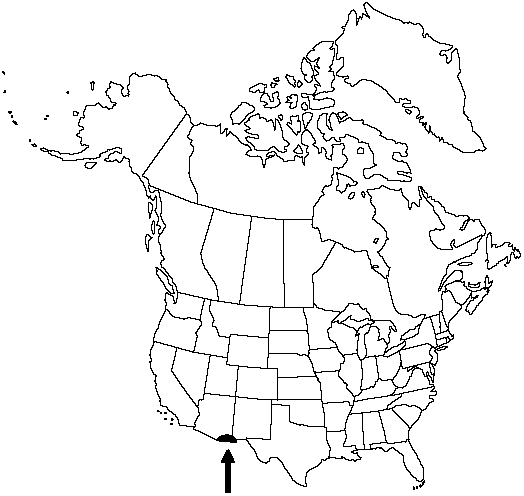Difference between revisions of "Pinus engelmannii"
3: 227. 1854.
FNA>Volume Importer |
FNA>Volume Importer |
||
| Line 25: | Line 25: | ||
}}<!-- | }}<!-- | ||
| − | --><span class="statement" id="st- | + | --><span class="statement" id="st-undefined" data-properties=""><b>Trees </b>to 35m; trunk to 0.6m diam., straight; crown irregularly rounded, rather thin. <b>Bark</b> dark brown, at maturity deeply furrowed, ridges becoming yellowish, of narrow, elongate, scaly plates. <b>Branches</b> straight to ascending; twigs stout (1–2cm thick), pale gray-brown, aging darker brown, rough. <b>Buds</b> ovoid-conic, to 2cm, resinous; scale margins pale fringed. <b>Leaves</b> 3(–5) per fascicle, spreading-ascending, often drooping, forming a brush at twig tips, persisting 2 years, (20–)25–45cm × 2mm, dull green, all surfaces with fine stomatal lines, margins coarsely serrulate, apex conic-subulate; sheath 3–4cm, base persistent. <b>Pollen</b> cones cylindric, ca. 25mm, yellow to yellow-brown. <b>Seed</b> cones maturing in 2 years and shedding seeds soon thereafter, not persistent, terminal, sometimes curved, often asymmetric, lance-ovoid before opening, ovoid when open, 11–14cm, light dull brown, nearly sessile or short-stalked; apophyses rhombic, somewhat to quite elongate, strongly raised toward outer cone base, sometimes curved, strongly cross-keeled, narrowed to thick, curved, broadly triangular-based umbo, this often producing outcurved claw. <b>Seeds</b> obovoid; body ca. 8–9mm, dark brown; wing to 20mm. <b>2n</b> =24.</span><!-- |
-->{{Treatment/Body | -->{{Treatment/Body | ||
| Line 54: | Line 54: | ||
|publication year=1854 | |publication year=1854 | ||
|special status= | |special status= | ||
| − | |source xml=https://jpend@bitbucket.org/aafc-mbb/fna- | + | |source xml=https://jpend@bitbucket.org/aafc-mbb/fna-data-curation.git/src/9216fc802291cd3df363fd52122300479582ede7/coarse_grained_fna_xml/V2/V2_789.xml |
|genus=Pinus | |genus=Pinus | ||
|species=Pinus engelmannii | |species=Pinus engelmannii | ||
| − | |||
| − | |||
| − | |||
| − | |||
| − | |||
| − | |||
| − | |||
| − | |||
| − | |||
| − | |||
| − | |||
| − | |||
| − | |||
| − | |||
| − | |||
| − | |||
| − | |||
| − | |||
| − | |||
| − | |||
| − | |||
| − | |||
| − | |||
| − | |||
| − | |||
| − | |||
| − | |||
| − | |||
| − | |||
| − | |||
| − | |||
| − | |||
| − | |||
| − | |||
| − | |||
| − | |||
| − | |||
| − | |||
| − | |||
| − | |||
| − | |||
| − | |||
| − | |||
| − | |||
| − | |||
| − | |||
| − | |||
| − | |||
| − | |||
| − | |||
| − | |||
| − | |||
| − | |||
| − | |||
| − | |||
| − | |||
| − | |||
| − | |||
| − | |||
| − | |||
| − | |||
}}<!-- | }}<!-- | ||
-->[[Category:Treatment]][[Category:Pinus]] | -->[[Category:Treatment]][[Category:Pinus]] | ||
Revision as of 13:27, 27 July 2019
Trees to 35m; trunk to 0.6m diam., straight; crown irregularly rounded, rather thin. Bark dark brown, at maturity deeply furrowed, ridges becoming yellowish, of narrow, elongate, scaly plates. Branches straight to ascending; twigs stout (1–2cm thick), pale gray-brown, aging darker brown, rough. Buds ovoid-conic, to 2cm, resinous; scale margins pale fringed. Leaves 3(–5) per fascicle, spreading-ascending, often drooping, forming a brush at twig tips, persisting 2 years, (20–)25–45cm × 2mm, dull green, all surfaces with fine stomatal lines, margins coarsely serrulate, apex conic-subulate; sheath 3–4cm, base persistent. Pollen cones cylindric, ca. 25mm, yellow to yellow-brown. Seed cones maturing in 2 years and shedding seeds soon thereafter, not persistent, terminal, sometimes curved, often asymmetric, lance-ovoid before opening, ovoid when open, 11–14cm, light dull brown, nearly sessile or short-stalked; apophyses rhombic, somewhat to quite elongate, strongly raised toward outer cone base, sometimes curved, strongly cross-keeled, narrowed to thick, curved, broadly triangular-based umbo, this often producing outcurved claw. Seeds obovoid; body ca. 8–9mm, dark brown; wing to 20mm. 2n =24.
Habitat: High and dry mountain ranges, valleys, and plateaus
Elevation: 1500–2500m
Distribution

Ariz., N.Mex., Mexico.
Discussion
In general appearance Pinus engelmannii much resembles P. palustris with its short-persistent, long leaves (but in this species drooping) and in its tendency to form a grass stage. It has a deep taproot as do P. palustris and P. ponderosa.
Selected References
None.